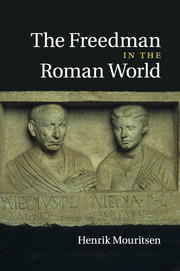Book contents
3 - Freedmen and their patrons
Published online by Cambridge University Press: 21 January 2011
Summary
The act of manumission did not transform the slave as a human being. In the eyes of society he still carried many of the moral and mental deficiencies associated with servitude. For example, even if he was adopted by a freeborn, the jurists insisted that legally he remained a freedman, a condition regarded as innate to his person; despite the change to his formal status he was in essence still a former slave. Naturally therefore a freedman could never become entirely equal to an ingenuus, and when he entered society as a free man he needed help and supervision. Logically this guidance would be provided by the former master, whose support – at least in theory – had enabled him to reach a level of personal development that qualified him for freedom. Manumission was therefore not supposed to terminate the relationship between the freedman and his former owner. Also after freedom had been granted the two were expected to be closely involved, and in many respects manumission merely redefined their relationship rather than bringing an end to it. The previous ownership was replaced by a new bond based on debt and gratitude for the ‘beneficium’ of freedom.
The new relationship between the freedman and his former master was constructed socially and legally through a combination of elements derived from different spheres of Roman life.
- Type
- Chapter
- Information
- The Freedman in the Roman World , pp. 36 - 65Publisher: Cambridge University PressPrint publication year: 2011



